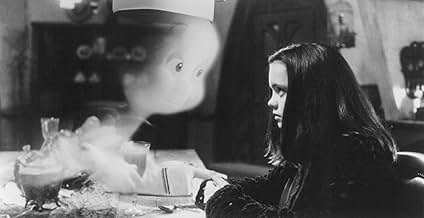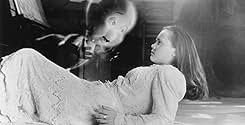Un esperto del paranormale e sua figlia si sistemano in una casa abbandonata dove vivono tre fantasmi dispettosi e uno simpatico.Un esperto del paranormale e sua figlia si sistemano in una casa abbandonata dove vivono tre fantasmi dispettosi e uno simpatico.Un esperto del paranormale e sua figlia si sistemano in una casa abbandonata dove vivono tre fantasmi dispettosi e uno simpatico.
- Premi
- 5 vittorie e 5 candidature
Malachi Pearson
- Casper
- (voce)
Fred Rogers
- Mr. Rogers
- (filmato d'archivio)
- (as Mr. Rogers)
Doug Bruckner
- Reporter
- (voce)
- (as Douglas J.O. Bruckner)
Joe Nipote
- Stretch
- (voce)
Joe Alaskey
- Stinkie
- (voce)
Brad Garrett
- Fatso
- (voce)
Trama
Lo sapevi?
- QuizThis is the first feature film to have a fully computer-generated visual effects character in a leading role.
- BlooperIn the classroom, Casper ties Amber's shoelaces together before anyone else's. When Amber stands up to protest the party being at Kat's house instead of hers, she doesn't trip over them. She sits back down, but when the bell rings and she gets up, she trips.
- Citazioni
Dr. Raymond Stantz: [runs out of the house frantic] Who you gonna call? Someone else.
- Curiosità sui creditiThe globe in the Universal logo fades into a full moon above Whipstaff Manor.
- ConnessioniEdited into Casper: Deleted Scenes (2003)
- Colonne sonoreCasper The Friendly Ghost
Written by Mack David and Jerry Livingston
Performed by Little Richard
Produced by Richie Zito and Little Richard
Arranged by Richie Zito
Recensione in evidenza
I don't view films as if I'm watching them as the intended audience; I watch them for myself. And that's why I found it odd at how engrossed I was when I watched this film for the first time at the age of eighteen. Aside from the great gothic flair of the mansion, two superbly placed cameos, and nice laughable black humour from the "trio," the film took off because of its emotional core. It's something that a youngster can really get into, but also anyone who finds it sad that a child can die. When Casper plays with his toys, I just wanted to start crying. This eternal child--lost and stuck in an age of mystery and wonder. And yet, he's smitten with a girl--he's starting to go through puberty. And it's just so sad . . . and beautiful.
And then there's the father, and his sway into the afterlife, his daughter's plight, her struggle with her wish to help Casper. It's all so simple and written for kids, but I was so engrossed by the romanticism of it all.
The villains mostly butt into the greatness of all of it, but you just have to grant that in a kid's picture. And now comes my but . . . in the end, when the mother does appear, she's supposed to be this amazing, angelic, deux es machinal, she floats through the stain glass window, her long hair flows around her, her gown flows all around her but--what the hell! why is her dress such a deep red!? she looks like satan! Oh well. Bad costume choice made a really bad moment. But mostly, I loved this film for it's good parts, despite the childishness of much of it.
And then there's the father, and his sway into the afterlife, his daughter's plight, her struggle with her wish to help Casper. It's all so simple and written for kids, but I was so engrossed by the romanticism of it all.
The villains mostly butt into the greatness of all of it, but you just have to grant that in a kid's picture. And now comes my but . . . in the end, when the mother does appear, she's supposed to be this amazing, angelic, deux es machinal, she floats through the stain glass window, her long hair flows around her, her gown flows all around her but--what the hell! why is her dress such a deep red!? she looks like satan! Oh well. Bad costume choice made a really bad moment. But mostly, I loved this film for it's good parts, despite the childishness of much of it.
- imbatman-2
- 31 ott 2000
- Permalink
I più visti
Accedi per valutare e creare un elenco di titoli salvati per ottenere consigli personalizzati
Dettagli
- Data di uscita
- Paese di origine
- Sito ufficiale
- Lingua
- Celebre anche come
- Casper: el fantasma amigable
- Luoghi delle riprese
- Rockport, Maine, Stati Uniti(Anonymous)
- Aziende produttrici
- Vedi altri crediti dell’azienda su IMDbPro
Botteghino
- Budget
- 55.000.000 USD (previsto)
- Lordo Stati Uniti e Canada
- 100.439.549 USD
- Fine settimana di apertura Stati Uniti e Canada
- 16.840.385 USD
- 28 mag 1995
- Lordo in tutto il mondo
- 288.039.549 USD
- Tempo di esecuzione1 ora 40 minuti
- Colore
- Mix di suoni
- Proporzioni
- 1.85 : 1
Contribuisci a questa pagina
Suggerisci una modifica o aggiungi i contenuti mancanti
























